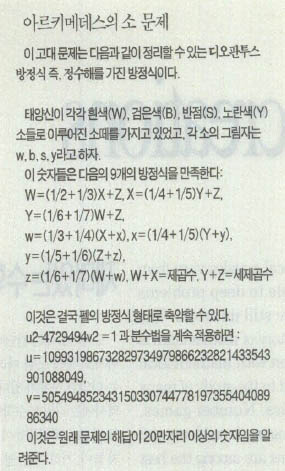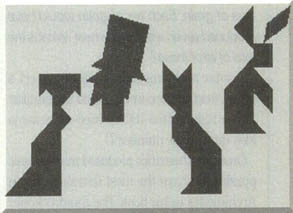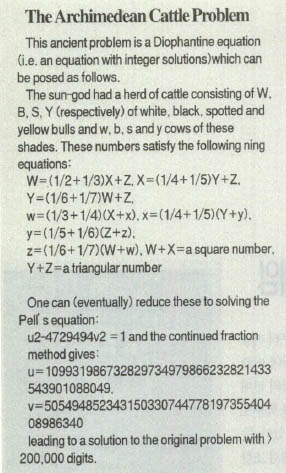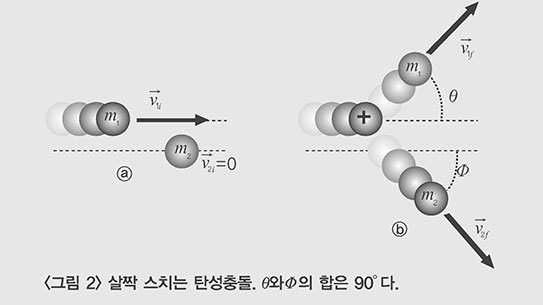'적당히가 통하지 않는 학문' 수학은 많은 사람들로부터 '가장 골치 아픈 과목'으로 여겨졌다. 그러나 치밀한 논리력과 풍부한 창의력을 요하는 수학이 이 지경으로 전락한 데는 단순 주입식으로 만사를 해결하려 한 우리의 교육제도 탓이다. 이번에 소개하는 Mac Tutor History of Mathematics Archive'(http://www-groups.dcs.st-and.ac.uk:80/~history/)는 1천여명의 수학자를 중심으로 수학사를 설명하고 있는 사이트로 수학과 수학사에 관심이 있는 사람이라면 반드시 가봐야할 사이트 중 하나다. 이곳에서는 수학자별, 연대별, 수학 분야별 등으로 수학과 관련된 궁금증을 풀어주며, 16세기부터 20세기에 이르는 수학사를 그림으로 소개하는 등 매우 풍성하고 다양한 정보들이 깔끔하게 정리돼 있다. 이 가운데 수학퍼즐에 대한 글 일부(http://www-groups.dcs.st-and.ac.uk/~history/HistTopics/Mathematical games.html)를 살펴보기로 한다.

재미있는 수학 게임
수학퍼즐에는 간단한 것부터 지금 까지도 풀지 못한 어려운 거셍 이르는 다양한 문제가 있다. 수학의 전체 역사에는 다양한 수학영역을 학문으로 이끈 수학퍼즐들이 섞여 있다. 숫자놀이, 기하퍼즐, 연결 무제와 조합 문제들은 가장 잘 아라려진 퍼즐들 가운데 하나다.
린드(Rhind) 파피루스는 초기 이집트의 수학이 퍼즐형태의 문제에 기반을 두고 잇음을 보여주고 있다. 예컨대 기원전 1850년경 쓰여진 파피루스는 오히려 퍼즐에 가까운 형태로 되어 있다.

일곱마리씩 고양이를 키우는 일곱 집이 있다. 이 고양이들은 일곱마리씩 쥐를 잡았는데. 이 쥐들은 각각 이리곱개의 낟알을 먹은 후였다. 이 낟알 꼭지에는 일곱 마리의 밀벌레가 막 나오려고 하고 있다. 이 모든 것들의 총합은 얼마인가?
유사한 문제가 1202년 쓰여진 피보나치의 'Liber Abaci라는 책에 나타나며, 세인트 이브스의 '18세기 수수께끼' 도 같은 아이디어(숫자 7에 대한)에 근거하고 있다.
그리스 수학에는 고적전인 퍼즐들이 많다. 이마도 가장 유명한 것은 아르키메데스와 그의 책 '모래를 세는 사람' 일텐데. 여기서 그는 소(牛)의 숫자 문제를 냈다.
만약 당신이 근면할 뿐만 아니라 총명하다면, 태양에 있는 소의 수를 계산해 보라.

이 문제에 대한 어떤 번역본들을 보면 소의 수는 206.545자리의 숫자인 것으로 드러났다.
또한 아르키메데서는 사각형을 14조각으로 나눠 그 조각들로 어떤 모양을 만드는 지혜놀이판(Tangr-am)과 유사한 놀이를 만들었다. 중국이 기원인 지혜놀이판은 수학적인 솜씨는 거의 필요하지 않다. 하지만 7개의 놀이판 조각으로 얼마나 많은 수의 모양을 만들 수 있는지 살펴보는 것은 매우 흥미로운 일이다. 또 한가지 주으해 볼 것은 7이란 숫자가 주술적인 특징과도 관련될 수 있다는 것이다.

위에서 이미 언급된 피보나치는 1,1,2,3,5,8,13,...으로 이어지는 수열을 개발할 것으로 유명하다. 각각의 수는 앞의 두 개 숫자의 합이다. 사실 수학이 풍성해진 것은 수열로 부터 시작됐는데, 오늘날 각종 잡지들에는 수열과 관련된 글들이 열심히 투고되고 있다. 하지만 피보나치의 연구 중에는 유명한 토끼문제를 빼곤 수열과 관련된 것은 보이지 않는다.
어떤 사람이 토끼 한 쌍을 사방이 벽으로 둘러싸인 곳에 두었다. 토끼 한 쌍이 매달마다 한 쌍씩의 새끼를 낳고, 새끼는 두달 후면 성장해 다시 새끼를 낳을 수 있다면, 1년 후에 토끼의 총수는 얼마인가?
아주 오래된 체스퍼즐 가운데 하나로 아랍 수학자 이반 칼리칸이 1256년 만든 밀알문제가 있다. '체스판의 첫째칸에는 1개를, 두번째 칸에는 2개를, 세번째는 4개를, 네번째는 8개를 놓는다면...' 하는 식이다.

또하나 오래된 문제중 하나인 체스 말을 이용한 방법은 1512년 구아리나 포를리가 시작했는데, 3×3의 체스판 모서리에 놓인 두 개의 백기사와 두 개의 흑기사가 자리를 바꾸는 방법에 대해서 질문했다(기사의 보총 움직임대로 할 때).
마방진은 1,2,3,...n2의 수를 n×n칸에 채워 넣어 열과 행, 대각선 각각의 합이 모두 같은 것을 말한다. 이것의 시작은 기원전 2200년까지 거슬러 올라가는데 중국에서 로슈라고 불렸다. 16세기 초 코넬리어스 아그립바는 3,4,5,6,7,8,9개의 n에 대한 마방진을 당시까지 알려진 7개의 행성(해와 달을 포함해)과 연관시켜 구성했다. 1514년 만들어진 듀러의 유명한 판화 멜랑콜리아에는 마방진 그림이 포함돼 있다.
주어진 차수의 해당하는 마방진 수에 관한 문제는 여전히 풀리지 않았다. 심지어 n=5인 것조차 아직 미해결로 남아 있다. 듀러의 사각형은 대칭이며, 모든 대각선방향(사각형을 토러스라고 가정하고 따라가면 수들의 합이 열이나 행의 합과 같다는 등의 다른 특징 들도 여전히 연구 되고 있다.
바셰는 시인으로, 번역자로 그리고 프랑스 학술원의 수학자로 명성를 펼쳤다. 그는 1621년 '디오판투스의 산술' 을 번역한 것으로 잘 알려져 있다. 이 책이 바로 페르마가 읽다가 그 유명한 최후의 정리를 끝 여백에다가 적어 놓았다는 책이다. 하지만 바셰는 1612년 출판한 '유쾌하고 신나는 숫자놀이' 라는 책에 실린 다양한 수학퍼즐의 수집자로서도 여깃 유명하다. 여기에는 강을 건너는 문제, 무게를 재는 문제, 숫자 요술, 마방진 등 지금까지 언급한 많은 문제들이 실려 있다. 여기 바셰의 무게를 재는 문제 중에 한 예를 든다.
만약 저울추가 저울 접시의 양쪽에 모두 놓일 수 있다면, 1부터 40파운드 사이에 정수에 해당하는 무게를 측정하기 위해서 사용하여야 하는 최소의 저울추는 몇 개인가?
Mathematical puzzles vary from the simple to deep problems which are still unsolved. The whole history of mathematics is interwovin with mathematical games which have led to the study of many areas of mathematics, Numver games, geometrical puzzles, network problems and combinatorial problems are among the best known types of puzzles.
The Rhind papyrus shows that early Egyptian mathematics was largely based on puzzle type problems. For example the papyrus, written in around 1850 BC, contains a rather familiar type of puzzle.
Seven houses contain sevin cats. Each cat kills seven mice. Each ear of grain world have produced seven worms of wheat. What is the total of all of these?
Similar problems appear in Fibinacci's Liber Avaci written in 1202 and the familiar St Ives Riddle of the 18C is based on the same idea (and on the number 7).
Greek mathematics produced many classic puzzles. Pehaps the most famous are from Archimedes in his book The Sandreckoner where he gives the Cattle Problem.
If thou art diligent and wise. O Stranger. compute the number of cattle of the Sun...

In some interpretationsof the problem the number of cattle turns to be a number with 206545 digits!
Archimedes also invented a division of a square into 14 pieces leading to a game similar to Tangrams involving making figures from the 14 pieces. Tangrams are of Chinese origin and require little mathematical skill. It is interesting however to see how many convex figures you can make from the 7 tangram pieces. Note again the number 7 which seems to have been associated with magical properties.
Fibonacci, already mentioned above, is famed for his invention of the sequence 1,1,2,3,5,8,13, ... where each number is the sum of the previous two. In fact a wealth of mathematics has arisen from this sequence and today a Journalis devoted to topics related to the sequence. However the sequence does not appear in Fibonacci's work only the famous Rabbit Problem.
A certain man put a pair of rabbits in a place surrounded on all sides by a wall. How many pairs of rabbits can be produced from that pair in a year if it is supposed that every month each pair begins a new pair which from the second manth on becomes productive?
One of the earliest mentions of Chess in puzzles is by the Arabic mathematician Ibn Kallikan who, in 1256, poses the problem of the grains of wheat. 1 on the first square of the chess board, 2 on the second, 4 on the third, 8 on the fourth etc. One of the earliest problem involving chess pieces is due to Guarini di Forli who in 1512 asked how tow white and tow black knights could be inter changed if they are placed at the corners of a 3×3 board (using normal knight's moves).
Magic squares involve using all the numbers 1,2,3, ... n2 to fill the squares of an n×n board so that each row, each column and both main diagonals sum to the same number. The are claimed to go back as far as 2200 BC when the Chinese called them lo-shu. In the early 15th Century Cornelius Agrippa constructed squares for n = 3,4,5,6,7,8,9 which he associated with the seven planets then known (including the Sun and the Moon). Durer's famous engraving of Melancholia made in 1514 includes a picture of a magic square.
The number of magic squares of a given order is still an unsolved problem. Even the case n = 5 remains unsolved. Durer's square is symmmetrical and other conditions were also studied such as the condition that all the diagonals(traced as if the square was on a torus) added to the same number as the row and column sum.
Bachet was famed as a poet, translator and early mathematician of the French Academy. He is best, known for his translation of 1621 of Diophantus' Arithmetica. This is the book which Fermat was reading when he inscribed the margin with his famous Last Theorem. Bachet, however, is also famed as a collector of mathematical puzzle which he published in 1612 Probl es plaisans et dlectables qui font par les nombers. It contains many of the problems referred to above, river crossing problems, weighing problems.
What is the least number of weights that can be used on a scale pan to weigh any integral number of pounds from 1 to 40 inclusive, if the weights can be placed in either of the sclae pans?

















